Pregnancy can be a wonderful time for many women, but it can also come with its fair share of discomfort. Back pain is a common issue experienced by pregnant women and can be caused by a variety of factors, including weight gain, changes in posture, and hormonal changes.
While there are many ways to alleviate back pain during pregnancy, some women may wonder about the possibility of safely pop a pregnant woman’s back, seeking techniques to relieve discomfort.
Back pain during pregnancy is a common complaint, affecting up to 70% of women at some point during their pregnancy. The pain can be mild or severe and may be felt in the lower back, upper back, or both.
It can be caused by a variety of factors, including weight gain, changes in posture, and hormonal changes.
As mentioned, weight gain, changes in posture, and hormonal changes are some of the most common causes of back pain in pregnant women. Other factors that can contribute to back pain during pregnancy include a lack of exercise, poor posture, and stress.
In some cases, back pain may be a sign of a more serious condition, such as preterm labor or a urinary tract infection.
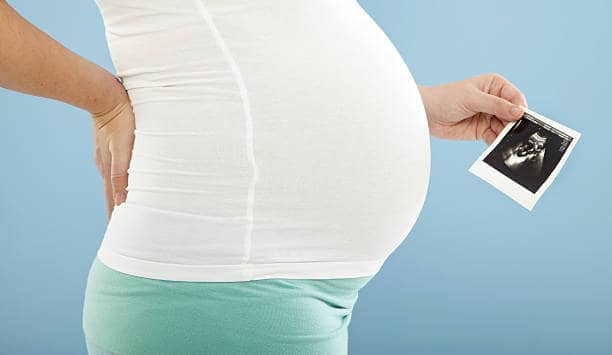
Key Takeaways
- Back pain is a common issue experienced by pregnant women and can be caused by a variety of factors.
- Weight gain, changes in posture, and hormonal changes are some of the most common causes of back pain in pregnant women.
- While popping a pregnant woman’s back may be helpful for some, it’s important to seek professional help if you’re experiencing severe or persistent back pain during pregnancy.
1. Understanding Back Pain During Pregnancy
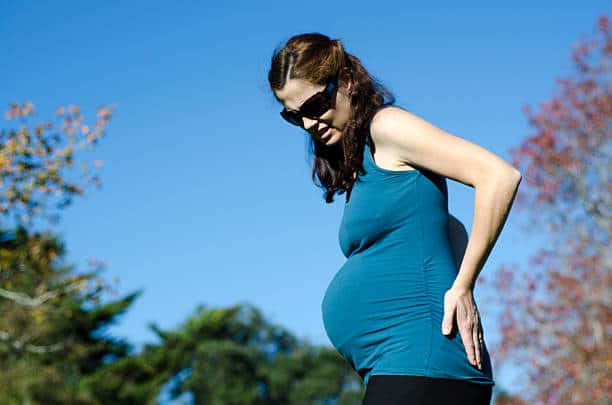
Back pain during pregnancy is a common issue that affects many women. As the body undergoes numerous changes to accommodate the growing fetus, the lower back, joints, ligaments, spine, and nerves are all placed under increased stress.
The center of gravity shifts forward, and weight gain can put additional pressure on the lower back, leading to discomfort and pain.
The severity of back pain during pregnancy can vary widely from woman to woman. For some, it may be a mild inconvenience that can be managed with simple lifestyle changes, while for others, it can be a debilitating condition that requires medical attention.
There are several factors that can contribute to back pain during pregnancy, including:
- Hormonal changes: During pregnancy, the body produces a hormone called relaxin, which helps to loosen the ligaments and joints in preparation for childbirth. However, this can also cause instability in the lower back and pelvis, leading to pain and discomfort.
- Weight gain: As the baby grows, the mother’s weight increases, which can put additional pressure on the lower back.
- Posture changes: As the center of gravity shifts forward, pregnant women may develop poor posture, which can strain the muscles and ligaments in the back.
- Stress: Pregnancy can be a stressful time, and stress can cause muscle tension and exacerbate existing back pain.
It is important for pregnant women to take steps to manage their back pain, including:
- Maintaining good posture: Pregnant women should try to stand up straight, with their shoulders back and their weight evenly distributed.
- Staying active: Regular exercise can help to strengthen the muscles in the back and reduce the risk of pain and discomfort.
- Wearing comfortable shoes: High heels and other uncomfortable shoes can put additional strain on the back, so it is important to wear supportive and comfortable footwear.
- Using supportive pillows: Pregnant women can use pillows to support their back while sitting or sleeping, which can help to reduce pain and discomfort.
In some cases, medical intervention may be necessary to manage back pain during pregnancy. Pregnant women should always consult with their healthcare provider before starting any new treatment or medication.
2. Causes of Back Pain in Pregnant Women

Back pain is a common complaint among pregnant women, affecting up to 80% of women at some point during their pregnancy. The causes of back pain in pregnant women are multifactorial and can be attributed to a combination of physiological, biomechanical, and hormonal changes that occur throughout pregnancy.
One of the primary causes of back pain in pregnant women is the increased weight and pressure placed on the lower back as the baby grows. This weight gain shifts the center of gravity forward, causing the lower back muscles to work harder to maintain balance.
Additionally, the expanding uterus puts pressure on the pelvis and hips, which can cause strain on the lower back muscles.
Hormonal changes during pregnancy can also contribute to back pain. The hormone relaxin is released during pregnancy to help loosen the ligaments in the pelvis in preparation for childbirth.
However, this hormone can also cause the ligaments in the lower back to become more relaxed, leading to instability and increased risk of injury.
In addition to these factors, poor posture, lack of exercise, and pre-existing conditions such as scoliosis or herniated discs can also contribute to back pain in pregnant women. It is important for pregnant women to maintain good posture and engage in regular exercise to help alleviate back pain and strengthen the muscles that support the spine.
Overall, back pain in pregnant women is a common and often expected symptom of pregnancy. However, by understanding the causes of back pain and taking steps to prevent and manage it, pregnant women can help ensure a more comfortable and healthy pregnancy.
3. Signs and Symptoms of Back Pain
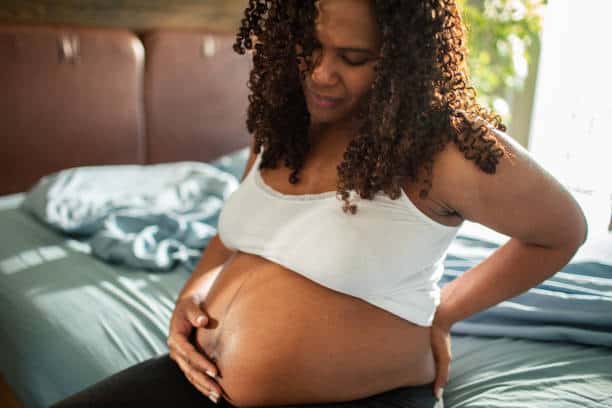
Back pain is a common complaint among pregnant women. It can occur at any time during pregnancy, but it is most common in the later stages.
The following are some signs and symptoms of back pain that pregnant women may experience:
- Lower back pain: This is the most common type of back pain during pregnancy. It can be a dull ache or a sharp pain that is felt in the lower back. This pain may be caused by the weight of the growing baby and the changes in the mother’s posture.
- Hip pain: Pregnant women may also experience pain in the hips. This can be caused by the stretching of the ligaments that support the uterus. The pain may be felt on one or both sides of the hips.
- Waist pain: Some pregnant women may experience pain in the waist area. This can be caused by the stretching of the muscles and ligaments in the abdomen.
- Abdominal pain: Abdominal pain during pregnancy can be a sign of a serious problem. If a pregnant woman experiences severe abdominal pain, she should seek medical attention immediately.
- Nerve pain: Some pregnant women may experience nerve pain, which can be felt as a shooting pain or a burning sensation. This type of pain may be caused by pressure on the nerves in the lower back.
It is important for pregnant women to pay attention to any back pain they may be experiencing. If the pain is severe or if it is accompanied by other symptoms, such as fever or vaginal bleeding, they should seek medical attention immediately.
4. Preventing Back Pain During Pregnancy
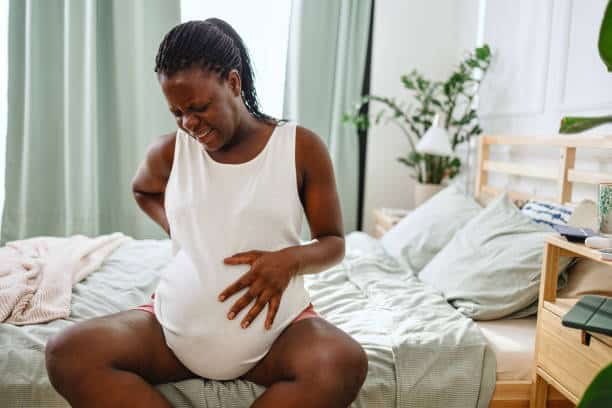
Back pain is a common issue during pregnancy due to the extra weight and strain on the body. However, there are several ways to prevent or alleviate back pain during pregnancy.
Maintaining good posture is essential during pregnancy. Pregnant women should avoid slouching and instead, keep their shoulders back and chest out.
They should also avoid standing for long periods and take frequent breaks to rest.
Regular physical activity can also help prevent back pain during pregnancy. Low-impact exercises such as walking, swimming, and prenatal yoga can help strengthen the muscles in the back, pelvis, hips, and waist.
However, pregnant women should consult with their doctor before starting any exercise routine.
When lifting objects, it is important to keep the knees bent and use the legs to lift rather than the back. Pregnant women should also avoid lifting heavy objects altogether if possible.
Wearing shoes with arch support and avoiding high heels can also help prevent back pain during pregnancy. Sleeping on the side with a pillow between the knees can also alleviate back pain.
In summary, pregnant women can prevent or alleviate back pain during pregnancy by maintaining good posture, engaging in regular physical activity, lifting properly, wearing supportive shoes, and sleeping on their side with a pillow between the knees.
5. Exercises and Stretches for Back Pain Relief

Back pain is a common problem during pregnancy due to the extra weight and pressure on the spine. Fortunately, there are several exercises and stretches that can help to alleviate this pain.
One effective exercise is the standing pelvic tilt. To perform this move, stand with your back against a wall and your feet shoulder-width apart.
Place your hands on your hips and tilt your pelvis forward, pressing your lower back against the wall. Hold for a few seconds before releasing and repeating.
Stretching is also important for back pain relief. One stretch that can be particularly helpful is the thigh stretch. To do this, sit on the floor with your legs extended in front of you.
Bend your right knee and place your foot on the floor, with your heel close to your buttocks. Place your left hand on your right knee and twist your torso to the right, looking over your right shoulder.
Hold for a few seconds before releasing and repeating on the other side.
Prenatal yoga is another great way to alleviate back pain. Many yoga poses focus on stretching and strengthening the muscles in the back, pelvis, and legs.
Some recommended poses include the cat-cow stretch, downward-facing dog, and child’s pose.
In addition to these exercises and stretches, it’s important to focus on strengthening the muscles in the back and pelvis. This can help to prevent future episodes of back pain.
Some effective moves include pelvic tilts, squats, and lunges.
Overall, incorporating exercises and stretches into your daily routine can help to alleviate back pain during pregnancy. It’s important to listen to your body and avoid any moves that cause discomfort.
6. Complementary Therapies for Back Pain

Pregnancy can be a wonderful experience, but it can also cause a lot of discomfort and pain, especially in the back. Back pain is a common complaint among pregnant women, and it can be caused by a variety of factors, including weight gain, hormonal changes, and changes in posture.
Fortunately, there are several complementary therapies that can help alleviate back pain during pregnancy.
Massage
Massage is a popular complementary therapy for back pain relief during pregnancy. It can help relieve tension in the muscles and improve circulation, which can help reduce pain and discomfort.
Prenatal massage is specifically designed for pregnant women and is generally safe when performed by a trained professional. However, it is important to consult with a healthcare provider before undergoing any type of massage therapy during pregnancy.
Heat and Cold Therapy
Heat and cold therapy are also effective complementary therapies for back pain relief. Heat therapy can help relax muscles and improve circulation, while cold therapy can help reduce inflammation and swelling.
A warm compress or heating pad can be applied to the affected area for 15-20 minutes at a time, while a cold compress or ice pack can be applied for 10-15 minutes at a time. It is important to avoid applying heat or cold directly to the skin and to use a barrier, such as a towel or cloth, to protect the skin.
Acupuncture
Acupuncture is a complementary therapy that involves the insertion of thin needles into specific points on the body. It can help relieve pain and improve circulation, and it is generally safe when performed by a licensed acupuncturist.
However, it is important to consult with a healthcare provider before undergoing acupuncture during pregnancy.
Prenatal Massage
Prenatal massage is a type of massage therapy that is specifically designed for pregnant women. It can help relieve tension in the muscles and improve circulation, which can help reduce pain and discomfort.
Prenatal massage is generally safe when performed by a trained professional, but it is important to consult with a healthcare provider before undergoing any type of massage therapy during pregnancy.
Complementary Therapies
Complementary therapies, such as yoga, meditation, and chiropractic care, can also be effective for back pain relief during pregnancy. Yoga and meditation can help reduce stress and tension in the muscles, while chiropractic care can help improve spinal alignment and reduce pressure on the nerves.
It is important to consult with a healthcare provider before undergoing any type of complementary therapy during pregnancy.
Overall, complementary therapies can be effective for back pain relief during pregnancy. However, it is important to consult with a healthcare provider before undergoing any type of therapy to ensure safety and effectiveness.
7. When to Seek Professional Help
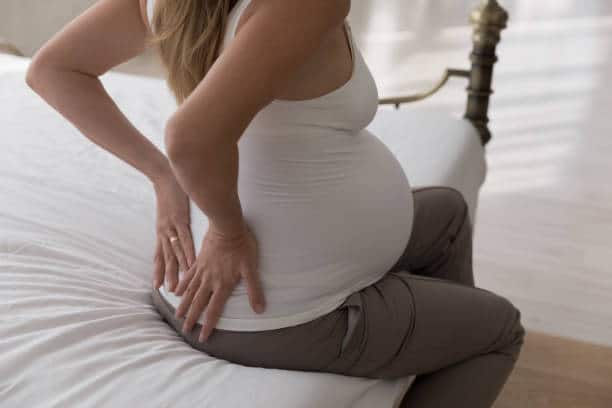
While popping a pregnant woman’s back can provide relief from back pain, it is important to know when to seek professional help. If the pregnant woman experiences severe or persistent back pain, it is recommended to consult with a healthcare provider before attempting any self-treatment.
Lower back pain is a common complaint during pregnancy, but it can also be a sign of a more serious condition such as preterm labor or a urinary tract infection. A healthcare provider can perform a physical exam and order any necessary tests to determine the cause of the back pain.
If the pregnant woman has a history of back problems or has experienced back pain before pregnancy, it is especially important to seek professional help. A chiropractor or physical therapist who specializes in treating pregnant women can provide safe and effective treatment options.
The American College of Obstetricians and Gynecologists recommends that pregnant women avoid high-impact activities and exercises that put stress on the back, such as running or jumping. It is also recommended to avoid lying on the back after the first trimester, as it can compress blood vessels and cause dizziness or fainting.
In summary, if a pregnant woman experiences severe or persistent back pain, has a history of back problems, or is unsure about the safety of popping her own back, it is important to seek professional help from a healthcare provider, chiropractor, or physical therapist who specializes in treating pregnant women.
8. Cracking Your Back While Pregnant
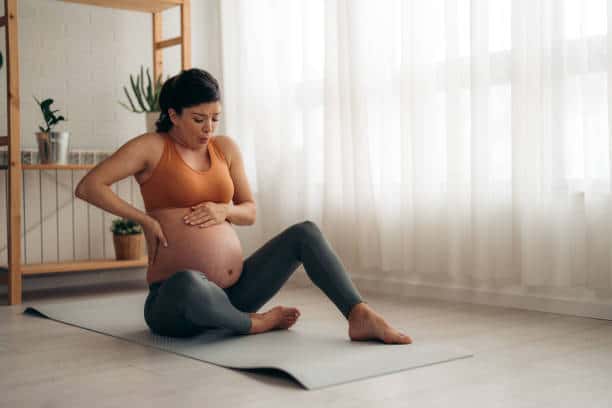
Pregnancy can be a challenging time for many women, and back pain is a common complaint during pregnancy. While there are many ways to relieve back pain, some women may wonder if it is safe to crack their back while pregnant.
Cracking your back can provide temporary relief from back pain, but it is important to do it safely. Pregnant women should avoid sudden movements or positions that put pressure on the lower back.
If you are experiencing back pain during pregnancy, it is recommended to consult with a chiropractor or physical therapist who specializes in prenatal care. They can provide safe and effective techniques to relieve back pain and help you maintain proper posture throughout your pregnancy.
It is important to note that cracking your back while pregnant should be done with caution. It is not recommended to use excessive force or twist your spine in a way that could cause injury.
In conclusion, cracking your back while pregnant can be a safe and effective way to relieve back pain, but it should be done with caution and under the guidance of a healthcare professional.
9. Potential Risks and Complications

When it comes to popping a pregnant woman’s back, there are several potential risks and complications that should be considered. While some women may find relief from back pain through this technique, it is important to understand the potential risks involved.
First, it is important to note that pregnancy can cause changes in the joints and ligaments, which can make them more prone to injury. This means that the risk of injury during a back popping session may be higher for pregnant women than for those who are not pregnant.
Another potential risk is preterm labor. While there is no direct evidence linking back popping to preterm labor, some healthcare professionals advise against it as a precautionary measure.
This is because the sudden movement involved in popping the back could potentially trigger contractions in a woman who is already at risk of preterm labor.
In addition to preterm labor, pregnant women are also at an increased risk of developing urinary tract infections (UTIs). This is because pregnancy can cause changes in the urinary tract that make it more susceptible to infection.
If a woman develops a UTI, she may experience symptoms such as pain or burning during urination, frequent urination, and fever. In some cases, a UTI can lead to more serious complications if left untreated.
Finally, it is important to note that popping the back may not be effective for all types of back pain. In some cases, the underlying cause of the pain may be more serious and require medical attention.
As such, pregnant women who are experiencing back pain should always consult with their healthcare provider before attempting any type of back popping or other self-care technique.
Overall, while popping a pregnant woman’s back may provide some relief for back pain, it is important to understand the potential risks and complications involved. Pregnant women should always consult with their healthcare provider before attempting any type of self-care technique to ensure that it is safe and appropriate for their individual needs.
Conclusion
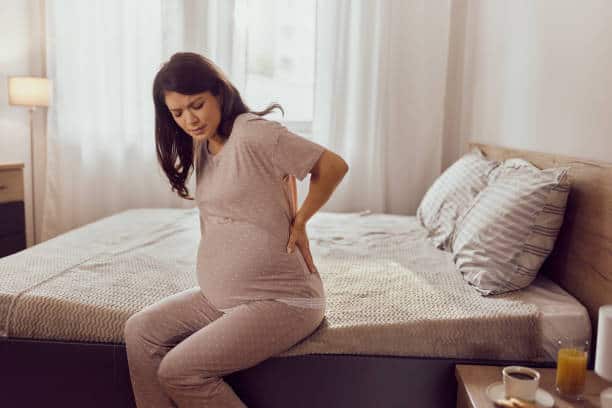
In conclusion, popping a pregnant woman’s back can provide much-needed relief from the discomfort and pain that often accompany pregnancy. However, it is important to approach this technique with caution and to seek the guidance of a healthcare professional before attempting it.
It is crucial to remember that every woman’s pregnancy is unique, and what may work for one woman may not work for another. Therefore, it is essential to consult with a trusted healthcare provider before attempting any new techniques or exercises.
Additionally, it is important to use proper form and technique when popping a pregnant woman’s back. This may include using props such as pillows or bolsters to support the woman’s body and to ensure that she is comfortable throughout the process.
Overall, popping a pregnant woman’s back can be a safe and effective way to alleviate discomfort and pain during pregnancy. However, it is important to approach this technique with caution and to seek the guidance of a healthcare professional before attempting it.
Related post: Can You Crack Your Back While Pregnant
Frequently Asked Questions
How can pregnant women relieve lower back pain?
Pregnant women can relieve lower back pain by practicing good posture, using a pregnancy support belt, and doing exercises that strengthen the muscles in the back and abdomen. Applying heat or cold therapy can also provide relief.
Is it safe to crack your neck or back while pregnant?
It is not recommended to crack your neck or back while pregnant as it can cause strain on the ligaments and muscles. This can lead to further discomfort and pain. It is best to seek the advice of a healthcare professional before attempting any adjustments.
What are some safe ways to adjust your back during pregnancy?
There are several safe ways to adjust your back during pregnancy, including using a pregnancy support pillow, getting regular chiropractic care from a qualified practitioner, and practicing gentle yoga poses that focus on spinal alignment.
How can pregnant women relieve upper back pain while sleeping?
Pregnant women can relieve upper back pain while sleeping by using a pregnancy support pillow that provides proper spinal alignment and supports the weight of the belly. Sleeping on the side with a pillow between the knees can also help alleviate pressure on the back.
What are some safe ways to decompress your spine during pregnancy?
Some safe ways to decompress the spine during pregnancy include using an inversion table, practicing gentle stretches that lengthen the spine, and using a foam roller to massage the muscles in the back.
Can using balm help with back pain during pregnancy?
Using balm can provide temporary relief for back pain during pregnancy, but it is important to choose a product that is safe for use during pregnancy and to follow the instructions carefully. It is also important to address the underlying cause of the pain, such as poor posture or muscle weakness, to prevent further discomfort.

Iesha is a loving mother of 2 beautiful children. She’s an active parent who enjoys indoor and outdoor adventures with her family. Her mission is to share practical and realistic parenting advice to help the parenting community becoming stronger.
